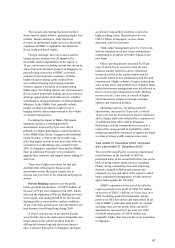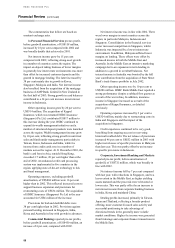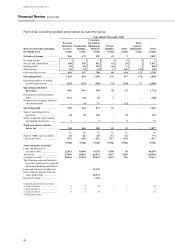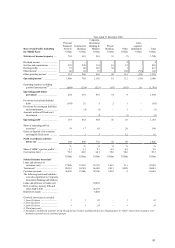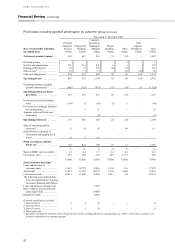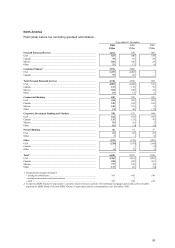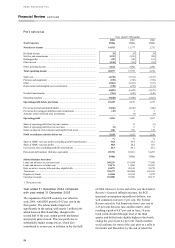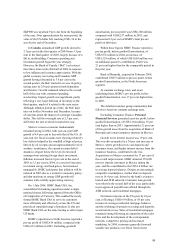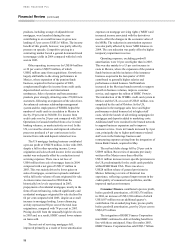HSBC 2004 Annual Report Download - page 99
Download and view the complete annual report
Please find page 99 of the 2004 HSBC annual report below. You can navigate through the pages in the report by either clicking on the pages listed below, or by using the keyword search tool below to find specific information within the annual report.97
of residential mortgages and US$15.6 billion of its
domestic private label assets to HSBC Bank USA,
the latter in December 2004. Under various service
level agreements, HSBC Finance Corporation will
continue to maintain the related customer account
relationships for the assets transferred. By the end of
2004, HSBC had provided a total of US$35.6 billion
in direct and client funding to HSBC Finance
Corporation, and cash savings realised in 2004 were
in excess of US$400 million.
Following receipt of regulatory approval for the
sale of the private label portfolio, and prior to the
sale, HSBC Finance Corporation adopted charge-off
and account management policies in accordance with
the Uniform Retail Credit Classification and Account
Management Policy issued by the Federal Financial
Institutions Examination Council (‘FFIEC policies’ ),
for its domestic private label, MasterCard and Visa
credit card portfolios. The main effect of this was on
the private label credit card portfolio, where the
FFIEC policies resulted in accounts being charged-
off earlier. Certain pools of accounts were already
following FFIEC policies, and so their adoption
improved conformity across all relevant portfolios.
The FFIEC account management practices change
the delinquency and roll rates applicable to these
portfolios, and resulted in a one-off charge to pre-tax
profit, before goodwill amortisation, of
US$154 million, which is expected to be offset by
future funding benefits in the region of
US$47 million per annum.
Net interest income of US$10,541 million was
US$2,690 million higher than in 2003, although on
an underlying basis adjusting for the additional
quarter in 2004, it was only marginally higher.
Average customer loan balances increased by 11 per
cent to US$120.6 billion. Lower funding costs gave
HSBC Finance Corporation the opportunity to
expand its prime and near-prime customer base,
particularly in the mortgage business. Average
mortgage balances grew by 23 per cent to
US$54.1 billion. Some US$3.9 billion of gross new
lending balances were originated from a single
correspondent relationship, while balances of
US$1.6 billion were originated following the launch
in 2003 of the ‘Secured Plus’ mortgage product.
Organic growth of 16 per cent to US$9.6 billion
in vehicle finance loans was primarily achieved
through a network of 5,200 motor dealers, extensive
alliance relationships and direct sales channels.
Loans in the MasterCard and Visa credit card
portfolios grew by 3 per cent to US$18 billion,
driven largely by growth in the sub-prime portfolio.
Spreads widened reflecting the change in product
mix towards the sub-prime market. The private label
business also achieved growth in average loan
balances, 5 per cent higher than in 2003, through
new and existing merchant agreements.
The benefit of strong growth in loan balances
was reduced significantly by lower yields. A greater
than normal run-off of older, higher-yielding loans,
product expansion into near-prime customer
segments, and competitive pricing pressures from
excess capacity, particularly in the mortgage market,
contributed to an overall decline in loan yields. The
decline was only partly offset by increased pricing of
variable-rate products in line with interest rate
movements, and continued growth in sub-prime
credit cards. Also, the adoption of the FFIEC
policies reduced net interest income by
US$57 million.
Other operating income rose by
US$895 million, or 52 per cent, to
US$2,602 million, largely reflecting the additional
quarter’s income. On an underlying basis, and
excluding the effect of adopting the FFIEC policies,
the increase was 10 per cent, predominantly
reflecting strong growth in fee income from credit
cards, and increased revenue from sales of value
added products.
Operating expenses, excluding goodwill
amortisation, of US$4,470 million were 44 per cent
higher than in 2003. On an underlying basis,
operating expenses, excluding goodwill
amortisation, increased by 10 per cent to
US$3,422 million due mainly to increased staff costs
and higher IT and marketing expenditure. Additional
staff were recruited in the branch network and in the
mortgage services business to support growth in
volumes and to improve customer service. Increased
business volumes also led to higher performance-
related bonuses and higher IT costs. Marketing costs
increased, largely due to changes in contractual
obligations associated with the General Motors co-
branded credit card portfolio, but were partly offset
by lower account origination costs. Marketing
expenses were also incurred in support of income
growth initiatives in the sub-prime market. In
September 2004, HSBC rebranded a number of its
Consumer Finance businesses at a cost of
US$8 million.
The charge for bad and doubtful debts rose by
17 per cent to US$5,136 million. On an underlying
basis and excluding the effect of adopting the FFIEC
policies, the charge fell by 12 per cent. This reflected
a marked improvement in credit quality, driven by
the economic upturn, improved origination, growth
in the proportion of secured lending, improved


